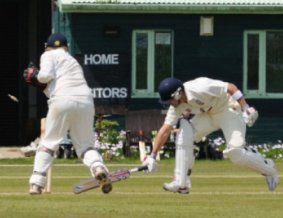
 |
| Index | |
|
|
|
|
|
| Run out  A batter should be given out Run out if he is out of his ground and the wicket is put down fairly while the ball is in play - even if it's a No ball As a simple example, the striker hits the ball and runs. If he has not grounded either his bat or some part of his person behind the popping crease at the other end before the wicket is put down at that end by one of the fielders with ball in hand, he should be given out The trouble with simple examples like that is precisely the fact that they are too simple! In many instances the position of both batters needs to be considered in order to work out who was out. Although the striker was running towards the wicket at the non-striker's end, he may not have been nearest to it at the instant that wicket was broken. If that is so then it is the non-striker who should be given out, since whoever is nearest to a wicket that is put down is the one who is out - not necessarily the batter who hit the ball in the first place If a batter has already made his ground but left it again to avoid being injured - by a throw-in perhaps - then he should not be given out, nor should he be if the delivery rebounds directly onto the stumps from a wicket-keeper or fielder's helmet If the striker hits a ball that breaks the wicket at the other end with the non-striker out of his ground, the non-striker should not be given out unless there was contact between any fielder and the ball in the time between the strike and the ball hitting the wicket Any runs completed before a Run out will count, together with the penalty for No ball or Wide, but the bowler does not receive the credit for a Run out. Finally no striker should be given out Run out if he was in fact Stumped |
||||||